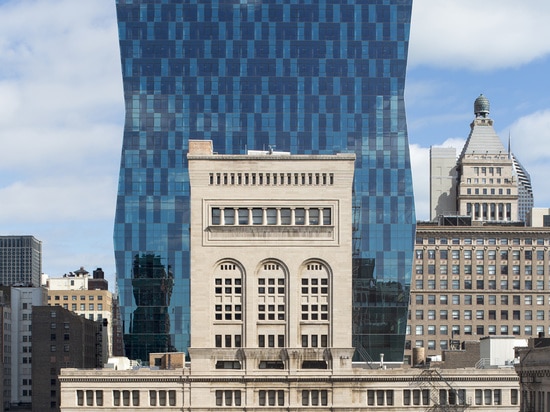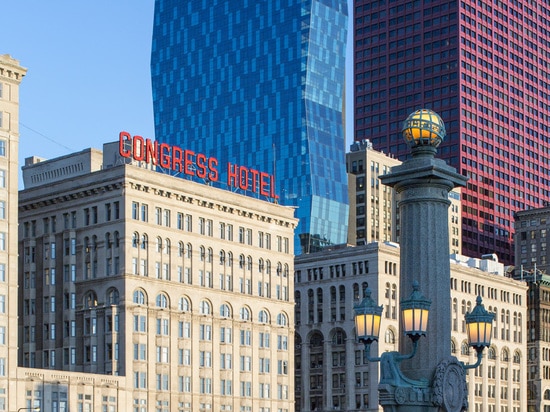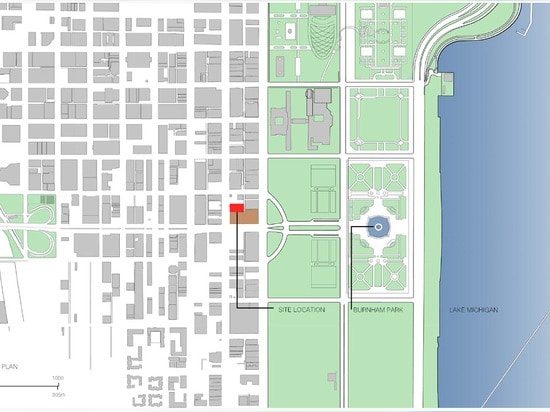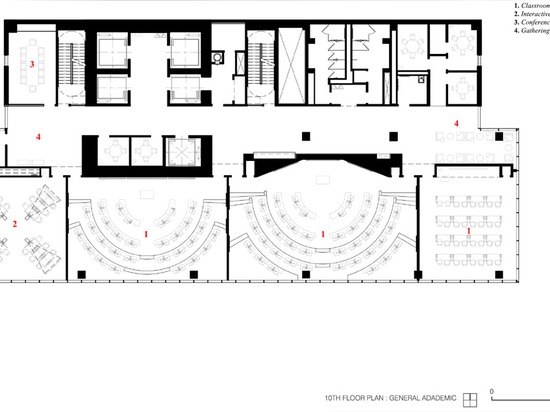
#PUBLIC ARCHITECTURE PROJECTS
Roosevelt University Academic, Student Life and Residence Center
In 1947, two years after its founding, Roosevelt University moved into the historic Auditorium Building in Chicago's Loop, after buying the building for a dollar.
Six decades later, in a downtown that has seen numerous transformations, including a developing cluster of nearby colleges and universities, Roosevelt has opened its 32-story Wabash Building, the second tallest collegiate building in the United States. The zig-zagging tower, just one block from Grant Park, cuts a striking profile on the downtown skyline. VOA Associates, architects for the new building, answered some questions about the unique tower.
What were the circumstances of receiving the commission for this project?
We received the commission through a response to an RFP followed by an interview process, which included five architectural firms, both local and national. Roosevelt University hired the John Buck Company as program manager, responsible for writing the RFP, conducting the search process, and organizing the interviews. The first interview was focused on qualifications and project approach; the second on design experience, but not proposals for the design of the actual project. Roosevelt University wanted to be assured that the team could produce a design that would stand out among its peers.Can you describe your design process for the building?
The design process started with an evaluation of the program and site. Roosevelt University is headquartered in the landmark Auditorium Building designed by Louis Sullivan and Dankmar Adler between 1887 and 1889. It was the first vertically organized mixed-use building combining what has become the world renowned Auditorium Theater, entertainment facilities, a hotel, and office space. The university's expansion is located adjacent to the Auditorium Building in a mid-block location on the west “City” side, facing Wabash Avenue and the elevated CTA tracks. A requirement of the program was to connect to the existing Auditorium Building on multiple levels to create a “campus”. This was extremely difficult given that the addition is located on the side of the theater, and finding space around it for a connection meant readjusting mechanical locations, working around the theater's facilities, and structurally setting back from the theater to clear the existing stepped foundations.
The program's 415,000 square feet is placed on this mid-block site of 17,300 square feet, preservging the façade of another historic building, the Fine Arts Annex designed by Andrew Rebori in 1927. The expansion is centered on creating large assembly classrooms that were non-existent in the Auditorium Building, as well as laboratories, the Colleges of Science and Business, student services and student life facilities, and 633 beds for student residences. It also includes a backstage warm-up and practice room for the Auditorium Theater as well as an elevator to serve the theater's ADA requirements. This was both a campus and an entire university situated in in one high-rise configuration.Our understanding and approach from the very beginning was to create a vertically organized university environment. Universities are typically laid out horizontally, connected by their open spaces to create the spontaneous, out-of-class opportunities vital to the academic experience. Our approach was to create a connection of "neighborhoods" through the use of vertical atrium spaces, as well as gathering spaces on specific levels that showcase the city views to the west and views of Burnham Park and Lake Michigan to the east. The second consideration was the placement of the core to allow for the intelligent stacking of the diverse functions; this allowed for the maximum possible span to accommodate the larger assembly spaces that are the core of the program. We offset the core and support “servant” spaces to the north, which in this mid-block location faces an adjacent existing building. Putting the “served” spaces on the south, adjacent to the Auditorium Building, allows for both connectivity and unencumbered views to the east and the south, once the building rises above the Auditorium Building.
The design process also involved finding expression for a University whose mission is based on the principles of Social Justice, which distinguishes this institution among its peers. Roosevelt University is based on the “transformative” values of social change through higher education. We wanted to express this idea of transformation by complementing and not diluting the power of the original Auditorium Building's architecture. The Auditorium Building, although highly influenced by H.H. Richardson’s Marshall Fields warehouse in Chicago, includes a tower rising out of itss classic block. This same feeling of rising out of the urban block is expressed in the series of stacked trapezoids. The geometry bows out on the east and the west expressing the social spaces and connecting atriums. The repetition of this shape, asymmetrically arranged, is reminiscent and inspired Constantin Brancusi’s “Endless Column”, which represents transcendence and transformation. The expansion continues a pattern of "tower rising out of the urban block," transforming the nature of a high-rise from a freestanding monument to a structure integrated in its urban fabric.The approach to materials involved complementing the Auditorium Building and enhancing its original expression. The south-facing facade, as well as the east and west sides, are sheathed in glass with a pattern of types that expresses the concept of gradation embodied in the Auditorium Building's openings and masonry. The new expansion is a counterpoint to the existing structure. The base of The Auditorium Building consists of darker, rough-cut granite and evolves into fine-cut and patterned limestone. The expansion reverses this by evolving from a lighter combination of glass panels at the base to a darker combination of panels at the top. The core is also expressed through darker precast panels that emerge from solid panels to a grill of smaller openings that integrate the mechanical openings and open up to window areas as the core steps back.
How does the completed building compare to the project as designed? Were there any dramatic changes between the two and/or lessons learned during construction?
Surprisingly, given the limitations of the budget, very few changes to the project happened between design and completion. Connecting atriums in the upper floors became too expensive due to smoke exhaust requirements, so larger, social-use exit stairs were designed as visible and colorful connecting routes between floors. Some details and materials had to be changed, but the overall work represents the original vision.
How does the building compare to other projects in your office, be it the same or other building types?
Our office is fortunate to have a deep history of metropolitan institutional clients and high-rise projects for over 20 years, primarily in government, health care and visible public institutions on Chicago's lakefront, including Navy Pier and McCormick Place. However a high-rise university was a new challenge for us and a unique model. Only a few examples exist, but none have the complete set of programs planned for the Roosevelt University's Wabash expansion.How does the building relate to contemporary architectural trends, be it sustainability, technology, etc.?
Contemporary architectural trends at their best aim to solve the multiple issues of sustainability: resource conservation, economics, social and cultural concerns. The decision by Roosevelt University to stay in place is the most significant component of a sustainable approach. Using a very small and encumbered site for a large program avails the university of the existing infrastructure: utilities, public transportation, and parking. Their decision continues and reenergizes their stewardship of the historically significant Auditorium Building and the adjacent historical structures which may be used in the future. It is a significant addition to the university environment that has generated the heterogeneity of uses in the Chicago Central Business District, making it a model for metropolitan centers throughout the world. The design reflects long-held principles of both our culture and the continuing evolution of the 1909 Burnham Plan, giving them new, exciting interpretations. The expansion, to be LEED certified, uses state-of-the-art technology appropriate for its university environment.
Are there any new/upcoming projects in your office that this building’s design and construction has influenced?
Yes, but only in principles and process. Architecture for us is not a process of developing form, but a process of developing meaning. It is about making the connection of the different phenomena of the environment rather than creating separations. We look to develop functionally superb and elegant solutions that connect to ideas beyond the scope of our particular commissions.




